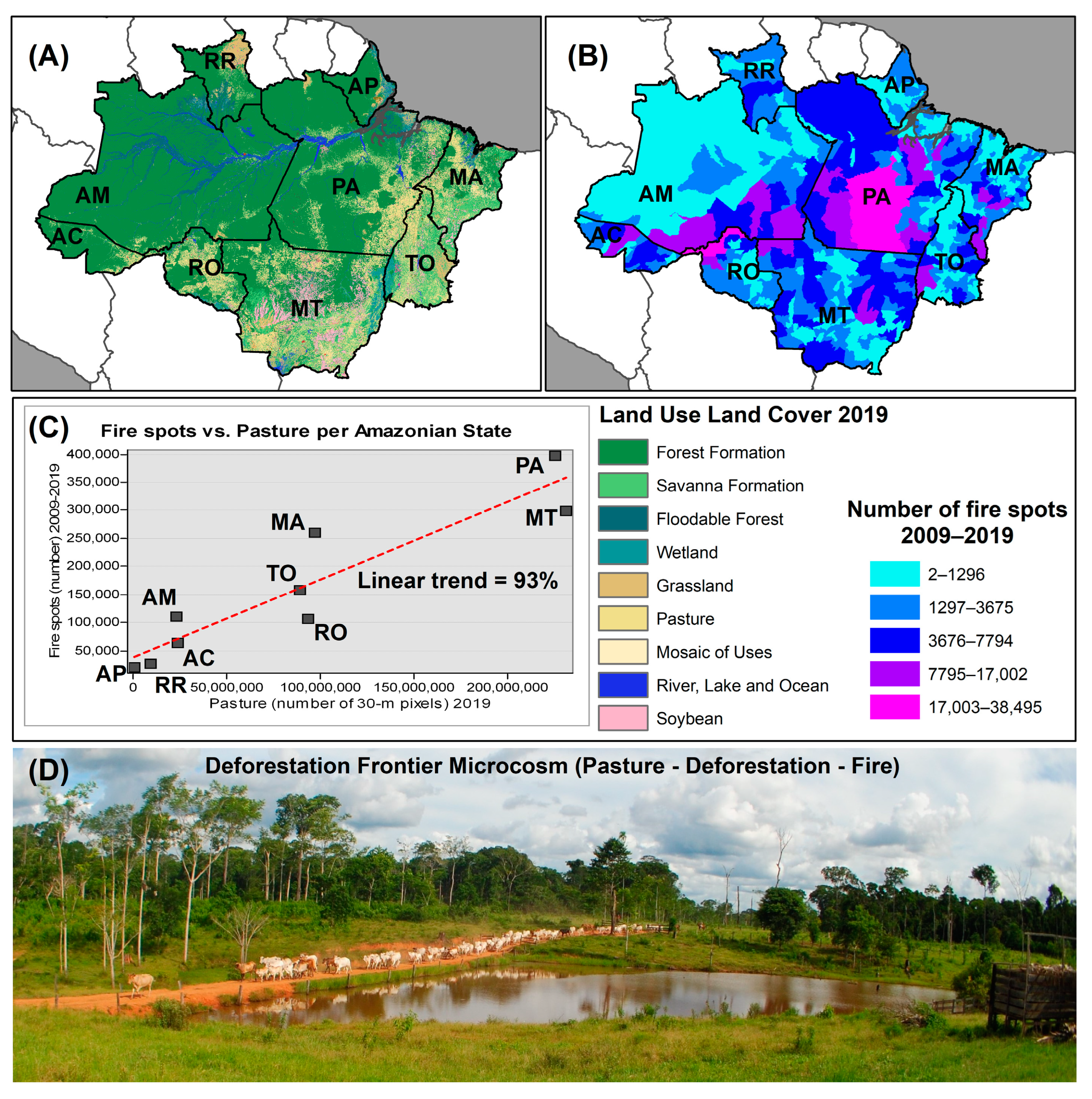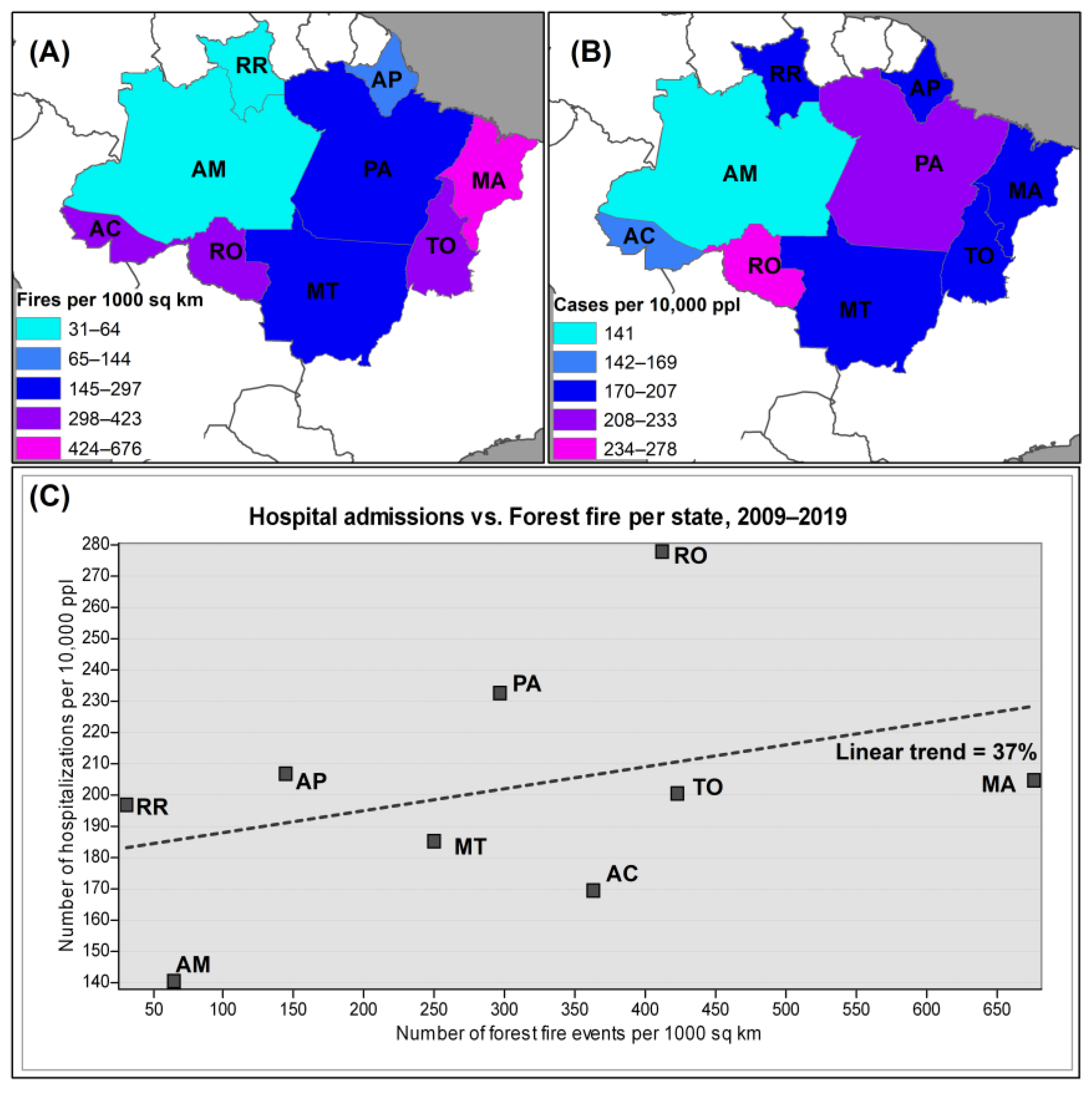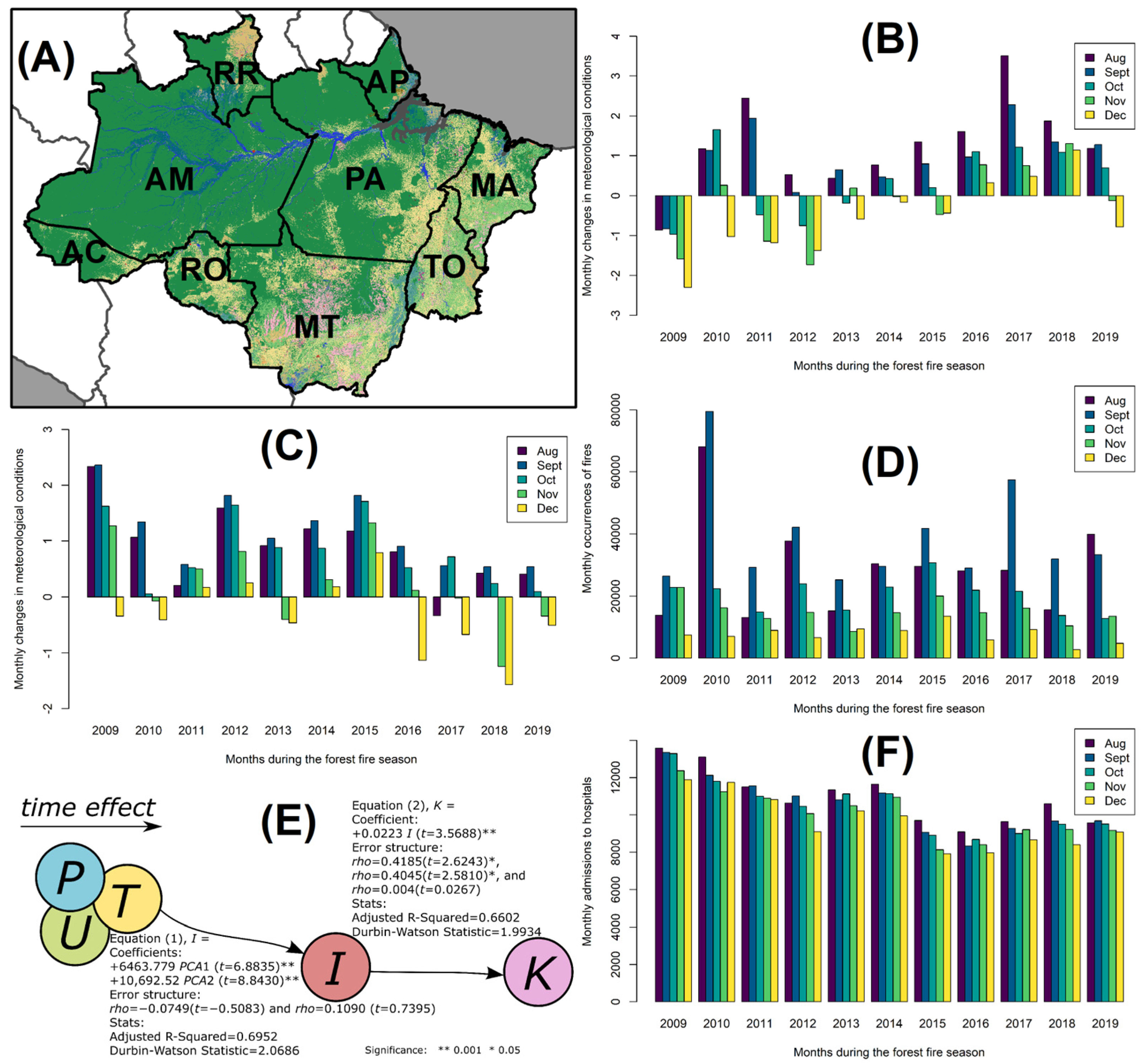Amazon Wildfires and Respiratory Health: Impacts during the Forest Fire Season from 2009 to 2019
Abstract
1. Introduction
2. Materials and Methods
2.1. Study Area and Rationale
2.2. Study Design and Variables
2.3. Sources of Data and Measurement
2.3.1. Hospital Admissions
- General by place of residence—from 2008 onwards;
- Geographic scope (states in the Legal Amazon);
- Row (year/month processing);
- Column (age groups <1 year, 1–14 years, and 60+ years; gender male and female);
- Content (hospitalizations);
- Available selections in the International Classification of Diseases-10-chapter X diseases of the respiratory system (J00–J99), listed as follows:
- Acute bronchitis and acute bronchiolitis;
- Acute laryngitis and tracheitis;
- Acute pharyngitis and acute tonsillitis;
- Asthma;
- Bronchiectasis;
- Chronic bronchitis, emphysema, and other chronic obstructive pulmonary diseases;
- Chronic diseases of tonsils and adenoids;
- Chronic sinusitis;
- Influenza;
- Pneumoconiosis or Pneumonia;
- Other diseases of the respiratory system.
2.3.2. Forest Fire
2.3.3. Climate Factors
2.4. Data Analysis and Modeling
3. Results
Evaluating Hypotheses on the Associations between Forest Fires and Hospital Admissions
4. Discussion
5. Conclusions
Author Contributions
Funding
Institutional Review Board Statement
Informed Consent Statement
Data Availability Statement
Acknowledgments
Conflicts of Interest
References
- Spracklen, D.V.; Garcia-Carreras, L. The Impact of Amazonian Deforestation on Amazon Basin Rainfall. Geophys. Res. Lett. 2015, 42, 9546–9552. [Google Scholar] [CrossRef]
- Morgan, W.T.; Darbyshire, E.; Spracklen, D.V.; Artaxo, P.; Coe, H. Non-Deforestation Drivers of Fires Are Increasingly Important Sources of Aerosol and Carbon Dioxide Emissions across Amazonia. Sci. Rep. 2019, 9, 16975. [Google Scholar] [CrossRef] [PubMed]
- Zemp, D.C.; Schleussner, C.-F.; Barbosa, H.M.J.; Rammig, A. Deforestation Effects on Amazon Forest Resilience. Geophys. Res. Lett. 2017, 44, 6182–6190. [Google Scholar] [CrossRef]
- Cochrane, M.A. Fire Science for Rainforests. Nature 2003, 421, 913–919. [Google Scholar] [CrossRef]
- Flor, M.J.P.D.S. Consequências Das Derrubadas e Queimadas de Vegetação: Práticas Utilizadas Pelos Agricultores Da Transassuruni Altamira Pará 2021. Rev. Alterjor 2022, 25, 261–282. [Google Scholar] [CrossRef]
- Butt, E.W.; Conibear, L.; Reddington, C.L.; Darbyshire, E.; Morgan, W.T.; Coe, H.; Artaxo, P.; Brito, J.; Knote, C.; Spracklen, D.V. Large Air Quality and Human Health Impacts Due to Amazon Forest and Vegetation Fires. Environ. Res. Commun. 2020, 2, 095001. [Google Scholar] [CrossRef]
- Butt, E.W.; Conibear, L.; Knote, C.; Spracklen, D.V. Large Air Quality and Public Health Impacts Due to Amazonian Deforestation Fires in 2019. GeoHealth 2021, 5, e2021GH000429. [Google Scholar] [CrossRef]
- Fearnside, P.M. Destruição e Conservação da Floresta Amazônica, 1st ed.; Editora INPA: Manaus, Brazil, 2022; ISBN 978-85-211-0193-2. [Google Scholar]
- Ribeiro, H.; Assunção, J.V.D. Efeitos Das Queimadas Na Saúde Humana. Estud. Avançados 2002, 16, 125–148. [Google Scholar] [CrossRef]
- Silva, A.M.C.D.; Mattos, I.E.; Ignotti, E.; Hacon, S.D.S. Material Particulado Originario de Queimadas e Doencas Respiratorias. Rev. Saúde Pública 2013, 47, 345–352. [Google Scholar] [CrossRef]
- Schraufnagel, D.E.; Balmes, J.R.; Cowl, C.T.; De Matteis, S.; Jung, S.-H.; Mortimer, K.; Perez-Padilla, R.; Rice, M.B.; Riojas-Rodriguez, H.; Sood, A.; et al. Air Pollution and Noncommunicable Diseases. Chest 2019, 155, 417–426. [Google Scholar] [CrossRef]
- Spracklen, D.V.; Arnold, S.R.; Taylor, C.M. Observations of Increased Tropical Rainfall Preceded by Air Passage over Forests. Nature 2012, 489, 282–285. [Google Scholar] [CrossRef] [PubMed]
- Silva, N.D.S.; Alves, J.M.B.; Silva, E.M.D.; Lima, R.R. Eventos Paleoclimáticos de El Niños, La Niñas e Neutros No Pacífico Tropical e de Precipitação No Sudoeste e Leste Da Amazônia. Rev. Bras. Meteorol. 2020, 35, 477–484. [Google Scholar] [CrossRef]
- Lee, Y.-G.; Lee, P.-H.; Choi, S.-M.; An, M.-H.; Jang, A.-S. Effects of Air Pollutants on Airway Diseases. Int. J. Environ. Res. Public Health 2021, 18, 9905. [Google Scholar] [CrossRef] [PubMed]
- Zadinello, A.L.; Silva, D.S.; Nascibem, J.L.; Araújo, K.C.D.S.; Pan, P.I.; Gomes, W.G.; Haum, T.O.; Guerra, A.G. Health Promotion Practices as an Agent against Atmospheric Pollution: An Integrative Review. Braz. J. Health Rev. 2021, 4, 17820–17831. [Google Scholar] [CrossRef]
- Urrutia-Pereira, M.; Varanda Rizzo, L.; José Chong-Neto, H.; Solé, D. Impact of Exposure to Smoke from Biomass Burning in the Amazon Rain Forest on Human Health. J. Bras. Pneumol. 2021, 47, e20210219. [Google Scholar] [CrossRef] [PubMed]
- Machado-Silva, F.; Libonati, R.; Melo De Lima, T.F.; Bittencourt Peixoto, R.; De Almeida França, J.R.; De Avelar Figueiredo Mafra Magalhães, M.; Lemos Maia Santos, F.; Abrantes Rodrigues, J.; DaCamara, C.C. Drought and Fires Influence the Respiratory Diseases Hospitalizations in the Amazon. Ecol. Indic. 2020, 109, 105817. [Google Scholar] [CrossRef]
- Amâncio, C.T.; Costa Nascimento, L.F. Asma e poluentes ambientais: Um estudo de séries temporais. Rev. Assoc. Med. Bras. 2012, 58, 302–307. [Google Scholar] [CrossRef] [PubMed]
- Anderson, L.; Marchezini, V. Mudanças Na Exposição Da População à Fumaça Gerada Por Incêndios Florestais Na Amazônia: O Que Dizem Os Dados Sobre Desastres e Qualidade Do Ar? Saúde Debate 2020, 44, 284–302. [Google Scholar] [CrossRef]
- Instituto de Pesquisa Ambiental da Amazônia (IPAM). The Air Is Unbearable-Health Impacts of Deforestation-Related Fires in the Brazilian Amazon. Available online: http://www.hrw.org/pt/report/2020/08/26/376135 (accessed on 19 December 2023).
- World Health Organization (WHO). Air Pollution: The Invisible Health Threat. Available online: https://www.who.int/news-room/feature-stories/detail/air-pollution--the-invisible-health-threat (accessed on 19 December 2023).
- Fernandes, A.S.S.; Terceiro, I.B. Queimadas e Doenças Respiratórias Em Crianças Na Cidade de Marabá, Pará/Fires and Respiratory Diseases in Children in the City of Marabá, Pará Incendios y Enfermedades Respiratorias En Niños de La Ciudad de Marabá, Pará. Braz. J. Health Rev. 2022, 5, 154–168. [Google Scholar] [CrossRef]
- Dos Santos, G.G.; De Araújo, R.G.; Neris, J.P.F.; De Sousa, J.S.; Da Silva, B.K.S.; Silva, V.D.S.; De Freitas, T.P.M. Análise Espacial e Temporal Dos Focos de Calor No Município de Anapu, Pará/Spatial and Temporal Analysis of Fire Focuses in the City of Anapu, Pará. Braz. J. Anim. Environ. Res. 2021, 4, 1739–1758. [Google Scholar] [CrossRef]
- Fernandes, T.; Hacon, S.D.S.; Novais, J.W.Z.; Gil, R.L.; Medeiros, N.B.C. Dinâmica Espaço-Temporal de Focos de Queimadas Na Área Fisiográfica Da Microrregião de Parauapebas-PA, Brasil. Rev. Gest. Sustentabilidade Ambient. 2019, 8, 340. [Google Scholar] [CrossRef]
- Lam, H.C.; Li, A.M.; Chan, E.Y.; Goggins, W.B. The Short-Term Association between Asthma Hospitalisations, Ambient Temperature, Other Meteorological Factors and Air Pollutants in Hong Kong: A Time-Series Study. Thorax 2016, 71, 1097–1109. [Google Scholar] [CrossRef] [PubMed]
- Silva Júnior, O.M.D.; Paiva, P.F.P.R.; Nascimento, A.D.N.T.D.; Braga, T.G.M.; Baia, M.M. Análise Dos Focos de Calor No Estado Do Amapá Entre Os Anos de 2017 a 2020. Rev. Ibero-Am. Ciênc. Ambient. 2021, 12, 622–631. [Google Scholar] [CrossRef]
- Floss, M.; Barros, E.F.; Fajardo, A.P.; Bressel, M.; Hacon, S.; Nobre, C.; Soranz, D.; Saldiva, P.; Pavão Patrício, K.; Knupp, D.; et al. Lancet Countdown: Briefing Para Políticas de Saúde No Brasil. Rev. Bras. Med. Fam. Comun. 2019, 14, 2286. [Google Scholar] [CrossRef]
- Floss, M.; Zandavalli, R.B.; Leão, J.R.B.; Lima, C.V.; Vianna, N.; Barros, E.F.; Saldiva, P.H.N. Poluição Do Ar: Uma Revisão de Escopo Para Recomendações Clínicas Para a Medicina de Família e Comunidade. Rev. Bras. Med. Fam. Comun. 2022, 17, 3038. [Google Scholar] [CrossRef]
- Drumond, R. O Que as Fronteiras Da Amazônia Legal Nos Contam Sobre as Diferenças de Desmatamento Entre Estado. Master’s Thesis, Fundação Getulio Vargas, Rio de Janeiro, Brazil, 2023. [Google Scholar]
- Instituto Brasileiro de Geografia e Estatística (IBGE). Mapa Da Amazônia Legal Atualizado. Available online: https://geoftp.ibge.gov.br/organizacao_do_territorio/estrutura_territorial/amazonia_legal/2021/mapa_da_amazonia_legal_2021.pdf (accessed on 19 December 2023).
- Mapeamento Anual do Uso e Cobertura da Terra no Brasil (MapBiomas). Land Use Land Cover. Available online: https://brasil.mapbiomas.org/ (accessed on 19 December 2023).
- Instituto Nacional de Pesquisas Espaciais (INPE). Portal de Monitoramento de Queimadas e Incêndios Florestais. Available online: http://www.inpe.br/queimadas (accessed on 19 December 2023).
- Instituto Nacional de Meteorologia (INMET). Rede de Estações Meteorológicas. Available online: https://mapas.inmet.gov.br/ (accessed on 19 December 2023).
- Ministério da Saúde Banco de Dados Do Sistema Único de Saúde—DATASUS. Informações de Saúde Tabnet. Epidemiológicas e Morbidade. Available online: http://tabnet.datasus.gov.br/cgi/tabcgi.exe?sih/cnv/nrac.def (accessed on 19 December 2023).
- Chen, Y.; Morton, D.C.; Jin, Y.; Collatz, G.J.; Kasibhatla, P.S.; Van Der Werf, G.R.; DeFries, R.S.; Randerson, J.T. Long-Term Trends and Interannual Variability of Forest, Savanna and Agricultural Fires in South America. Carbon Manag. 2013, 4, 617–638. [Google Scholar] [CrossRef]
- Time Series and Econometric Modeling Bimets: R Package Version 3.0.1. Available online: https://cran.r-project.org/web/packages/bimets/index.html (accessed on 19 December 2023).
- Carvalho, N.S.; Anderson, L.O.; Nunes, C.A.; Pessôa, A.C.M.; Silva Junior, C.H.L.; Reis, J.B.C.; Shimabukuro, Y.E.; Berenguer, E.; Barlow, J.; Aragão, L.E.O.C. Spatio-Temporal Variation in Dry Season Determines the Amazonian Fire Calendar. Environ. Res. Lett. 2021, 16, 125009. [Google Scholar] [CrossRef]
- Mekhuri, S.; Quach, S.; Barakat, C.; Sun, W.; Nonoyama, M.L. A Cross-Sectional Survey on the Effects of Ambient Temperature and Humidity on Health Outcomes in Individuals with Chronic Respiratory Disease. Can. J. Respir. Ther. 2023, 59, 256–269. [Google Scholar] [CrossRef] [PubMed]
- Lou, H.; Zhang, J.; Yang, S.; Cai, M.; Ren, X.; Luo, Y.; Li, C. Exploring the Relationships of Atmospheric Water Vapor Contents and Different Land Surfaces in a Complex Terrain Area by Using Doppler Radar. Atmosphere 2021, 12, 528. [Google Scholar] [CrossRef]
- Marengo, J.A.; Tomasella, J.; Alves, L.M.; Soares, W.R.; Rodriguez, D.A. The Drought of 2010 in the Context of Historical Droughts in the Amazon Region. Geophys. Res. Lett. 2011, 38. [Google Scholar] [CrossRef]
- Singh, M.; Zhu, X. Analysis of How the Spatial and Temporal Patterns of Fire and Their Bioclimatic and Anthropogenic Drivers Vary across the Amazon Rainforest in El Niño and Non-El Niño Years. PeerJ 2021, 9, e12029. [Google Scholar] [CrossRef] [PubMed]
- Rocha, L.C.S.; Rauber, A.L. Brazilian Legal Amazon: The Incidence of Hotspots between 2001 and 2020 and the Correlation with Clear-Cut Deforestation. Rev. Equador 2023, 12, 199–226. [Google Scholar]
- Miranda, Y.C.; Silva, K.M.D.; Nunes, A.C.; Martins, A.C.; Santos, D.D.A.D.; Dupas, F.A.; Camilo, R.; Oliveira, R.P.D. Uma Visão Sobre Incêndios Florestais Em Regiões Climatológicas Distintas: Uma Análise Da Área Queimada Na Amazônia Legal e Na Província de Alberta. In Pesquisas Multidisciplinares Aplicadas ao Meio Ambiente; Bookerfield: São Paulo, Brazil, 2021; Volume 2, pp. 75–89. [Google Scholar]
- De Paula Santos, U.; Abdo Arbex, M.; Ferreira Braga, A.L.; Futoshi Mizutani, R.; Delfini Cançado, J.E.; Terra-Filho, M.; Chatkin, J.M. Environmental Air Pollution: Respiratory Effects. J. Bras. Pneumol. 2021, 47, e20200267. [Google Scholar] [CrossRef] [PubMed]
- de Oliveira, I.N.; de Oliveira, B.F.A.; da Silveira, I.H.; Machado, L.M.G.; Villardi, J.W.R.; Ignotti, E. Air Pollution from Forest Burning as Environmental Risk for Millions of Inhabitants of the Brazilian Amazon: An Exposure Indicator for Human Health. Cad. Saude Publica 2023, 39, e00131422. [Google Scholar] [CrossRef]
- Santos, A.M.D.; da Silva, C.F.A.; de Almeida Junior, P.M.; Rudke, A.P.; de Melo, S.N. Deforestation Drivers in the Brazilian Amazon: Assessing New Spatial Predictors. J. Environ. Manag. 2021, 294, 113020. [Google Scholar] [CrossRef]
- Lapola, D.M.; Pinho, P.; Barlow, J.; Aragão, L.E.O.C.; Berenguer, E.; Carmenta, R.; Liddy, H.M.; Seixas, H.; Silva, C.V.J.; Silva-Junior, C.H.L.; et al. The Drivers and Impacts of Amazon Forest Degradation. Science 2023, 379, eabp8622. [Google Scholar] [CrossRef]
- Dutra, D.J.; Anderson, L.O.; Fearnside, P.M.; Graça, P.M.L.D.A.; Yanai, A.M.; Dalagnol, R.; Burton, C.; Jones, C.; Betts, R.; Aragão, L.E.O.E.C.D. Fire Dynamics in an Emerging Deforestation Frontier in Southwestern Amazonia, Brazil. Fire 2022, 6, 2. [Google Scholar] [CrossRef]
- Andrade Filho, V.S. Estudo Da Associação Entre Material Particulado Emitido Em Queimadas e Doenças Respiratórias No Município de Manaus, AM. Master’s Thesis, Instituto Nacional de Pesquisas Da Amazônia, Manaus, Brasil, 2011. [Google Scholar]
- National Aeronautics and Space Administration (NASA). Earth Observatory Drought Fuels Wildfires in the Amazon. Available online: https://earthobservatory.nasa.gov/images/151965/drought-fuels-wildfires-in-the-amazon (accessed on 19 December 2023).
- Oxford Analytica Brazil’s Amazon Drought Poses Environmental Challenges, Expert Briefings. Available online: https://www.emerald.com/insight/content/doi/10.1108/OXAN-DB283547/full/html (accessed on 19 December 2023).
- Lugo-Carvajal, A.; Holmgren, M.; Zuanon, J.; Van Der Sleen, P. Fish on Fire: Shifts in Amazonian Fish Communities after Floodplain Forest Fires. J. Appl. Ecol. 2023, 60, 1637–1646. [Google Scholar] [CrossRef]
- Instituto de Desenvolvimento Sustentável Mamirauá (IDSM). ‘Ebulição’ Amazônica: A Emergência Dos Botos-Vermelhos e Tucuxis No Amazonas. Available online: https://mamiraua.org.br/noticias/emergencia-de-botos# (accessed on 21 December 2023).
- Bayram, H.; Rice, M.B.; Abdalati, W.; Akpinar Elci, M.; Mirsaeidi, M.; Annesi-Maesano, I.; Pinkerton, K.E.; Balmes, J.R. Impact of Global Climate Change on Pulmonary Health: Susceptible and Vulnerable Populations. Ann. Am. Thorac. Soc. 2023, 20, 1088–1095. [Google Scholar] [CrossRef]
- Li, J.; Cai, Y.S.; Kelly, F.J.; Wooster, M.J.; Han, Y.; Zheng, Y.; Guan, T.; Li, P.; Zhu, T.; Xue, T. Landscape Fire Smoke Enhances the Association between Fine Particulate Matter Exposure and Acute Respiratory Infection among Children under 5 Years of Age: Findings of a Case-Crossover Study for 48 Low- and Middle-Income Countries. Environ. Int. 2023, 171, 107665. [Google Scholar] [CrossRef]
- Uttajug, A.; Ueda, K.; Honda, A.; Takano, H. Estimation of Hospital Visits for Respiratory Diseases Attributable to PM10 from Vegetation Fire Smoke and Health Impacts of Regulatory Intervention in Upper Northern Thailand. Sci. Rep. 2022, 12, 18515. [Google Scholar] [CrossRef] [PubMed]
- Ye, T.; Xu, R.; Yue, X.; Chen, G.; Yu, P.; Coêlho, M.S.Z.S.; Saldiva, P.H.N.; Abramson, M.J.; Guo, Y.; Li, S. Short-Term Exposure to Wildfire-Related PM2.5 Increases Mortality Risks and Burdens in Brazil. Nat. Commun. 2022, 13, 7651. [Google Scholar] [CrossRef] [PubMed]
- Leibel, S.; Nguyen, M.; Brick, W.; Parker, J.; Ilango, S.; Aguilera, R.; Gershunov, A.; Benmarhnia, T. Increase in Pediatric Respiratory Visits Associated with Santa Ana Wind–Driven Wildfire Smoke and PM2.5 Levels in San Diego County. Ann. Am. Thorac. Soc. 2020, 17, 313–320. [Google Scholar] [CrossRef] [PubMed]
- Aguilera, R.; Corringham, T.; Gershunov, A.; Leibel, S.; Benmarhnia, T. Fine Particles in Wildfire Smoke and Pediatric Respiratory Health in California. Pediatrics 2021, 147, e2020027128. [Google Scholar] [CrossRef]





| Rotation and Importance of Components | PCA1 | PCA2 |
|---|---|---|
| Precipitation (loading factor) | −0.5101571 | −0.713132017 |
| Temperature (loading factor) | −0.5171063 | 0.701027195 |
| Relative humidity (loading factor) | −0.6872706 | 0.001896973 |
| Explained variance proportion | 0.6741 | 0.2976 |
| Cumulative explained variance proportion | 0.6741 | 0.9717 |
Disclaimer/Publisher’s Note: The statements, opinions and data contained in all publications are solely those of the individual author(s) and contributor(s) and not of MDPI and/or the editor(s). MDPI and/or the editor(s) disclaim responsibility for any injury to people or property resulting from any ideas, methods, instructions or products referred to in the content. |
© 2024 by the authors. Licensee MDPI, Basel, Switzerland. This article is an open access article distributed under the terms and conditions of the Creative Commons Attribution (CC BY) license (https://creativecommons.org/licenses/by/4.0/).
Share and Cite
Ribeiro, M.R.; Lima, M.V.M.; Ilacqua, R.C.; Savoia, E.J.L.; Alvarenga, R.; Vittor, A.Y.; Raimundo, R.D.; Laporta, G.Z. Amazon Wildfires and Respiratory Health: Impacts during the Forest Fire Season from 2009 to 2019. Int. J. Environ. Res. Public Health 2024, 21, 675. https://doi.org/10.3390/ijerph21060675
Ribeiro MR, Lima MVM, Ilacqua RC, Savoia EJL, Alvarenga R, Vittor AY, Raimundo RD, Laporta GZ. Amazon Wildfires and Respiratory Health: Impacts during the Forest Fire Season from 2009 to 2019. International Journal of Environmental Research and Public Health. 2024; 21(6):675. https://doi.org/10.3390/ijerph21060675
Chicago/Turabian StyleRibeiro, Maura R., Marcos V. M. Lima, Roberto C. Ilacqua, Eriane J. L. Savoia, Rogerio Alvarenga, Amy Y. Vittor, Rodrigo D. Raimundo, and Gabriel Z. Laporta. 2024. "Amazon Wildfires and Respiratory Health: Impacts during the Forest Fire Season from 2009 to 2019" International Journal of Environmental Research and Public Health 21, no. 6: 675. https://doi.org/10.3390/ijerph21060675
APA StyleRibeiro, M. R., Lima, M. V. M., Ilacqua, R. C., Savoia, E. J. L., Alvarenga, R., Vittor, A. Y., Raimundo, R. D., & Laporta, G. Z. (2024). Amazon Wildfires and Respiratory Health: Impacts during the Forest Fire Season from 2009 to 2019. International Journal of Environmental Research and Public Health, 21(6), 675. https://doi.org/10.3390/ijerph21060675








